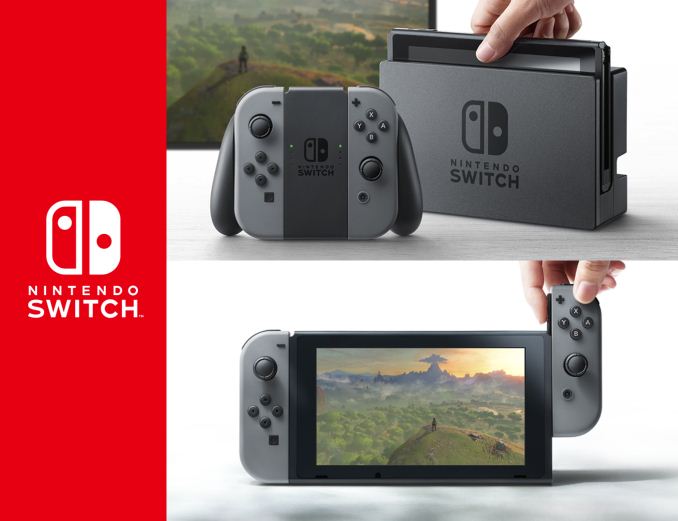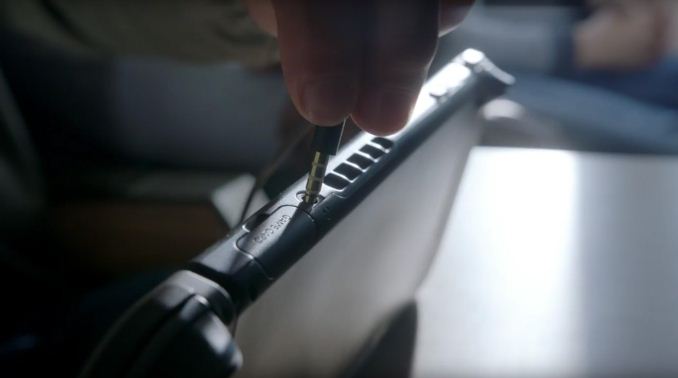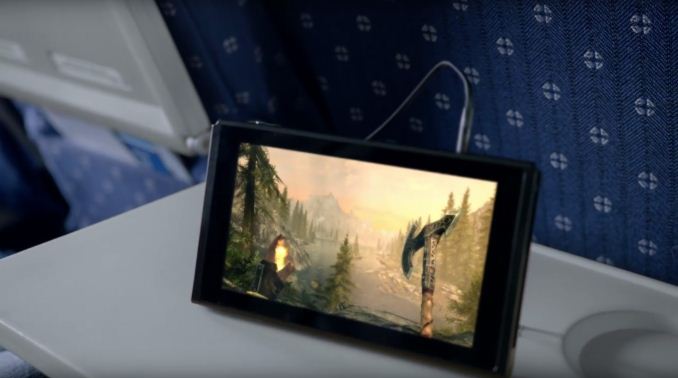Nintendo Announces Switch Portable Gaming Console - Powered by NVIDIA Tegra
by Ryan Smith on October 20, 2016 4:25 PM EST
Earlier today Nintendo took the wraps off of their next generation console, Switch. Formerly known by the codename NX, the Switch is the successor to both Nintendo’s portable DS and set top Wii console lines, utilizing a portable, tablet-like unit that can be docked to behave like a set top console. Today’s announcement, in the form of a 3 minute trailer, is meant to tease the console ahead of its full launch in March of 2017.
While I’ll skip the commentary on the console’s unusual design – dedicated gaming sites can offer better context – I wanted to dive into the hardware in the Switch. Given that this was a teaser, I was not expecting a reveal of any of the hardware specifications of the console, and indeed neither Nintendo’s teaser video nor their related press release made any mention of the underlying hardware. However shortly after the reveal went live, NVIDIA sent out an email to the press and posted a blog of their own. As it turns out, while today is still just a teaser, in some ways we’re already getting more information about the console than in any previous generation of Nintendo’s hardware.
In their blog post, NVIDIA confirmed that they would be providing the underlying SoC for the console. As this is still ultimately a teaser, NVIDIA’s own details are light, but their announcement confirms that it’s a custom version of their Tegra SoC. Curiously, no mention of the CPU core in that SoC is mentioned. However as it’s a Tegra, something ARM-based is the logical (if not only) choice. And on the GPU side, as you’d expect, they’re using a GPU based on one of NVIDIA’s existing GPU architectures, though the company isn’t specifying if it’s Pascal or Maxwell (I’d assume Pascal, but consoles are known for their long development cycles).
Otherwise, as far as specifications go that’s all we get for now. Though as NVIDIA is supplying a whole SoC there are obviously many more parts to the package that we’ll hopefully learn about in the near future. More CPU and GPU details are obviously the most interesting aspect – does the Switch SoC use Denver CPU cores? – but there’s also the matter of memory bandwidth, WiFi support, and the many other functional blocks that make up an SoC.
For NVIDIA, this is the first console hardware win for the company since the PlayStation 3, which launched in 2006. In the set top console market, AMD has since provided the GPU (and often, the CPU) for the most recent generation of consoles. Otherwise NVIDIA has never had a 3rd party portable console win, primarily because both Nintendo and Sony developed their respective SoCs internally for the 3DS and Vita.
In fact, given that Nintendo previously did much of their portable console development work internally, this is a notable shift for how the company operates. The 3DS was essentially a custom SoC combining multiple ARM11 (ARMv6) CPU cores with an OpenGL ES 1.1 generation GPU from the little-known Digital Media Professionals (DMP). So this is the first time Nintendo has contracted out their SoC needs to a third party in such a visible fashion. I’m actually a bit surprised that NVIDIA is even allowed to talk about their involvement at this point in time, given Nintendo’s historical focus on secrecy.
Though all of this also helps to underline just how big a jump in technology the Switch is from the 3DS. On the CPU side alone it’s reasonable to assume we’re looking at CPU design in the neighborhood of 4.x DMIPS/MHz, versus ARM11’s approximate 1.3 DIMPS/MHz rate, so IPC will have increased significantly, never mind an increase in frequency. Meanwhile on the GPU side, Nintendo is going from a GPU that didn’t even have a programmable GPU pipeline (i.e. shaders) to a fully modern GPU, essentially catching up on a decade of mobile GPU development in a single bound. Given that the console has to work as both the company’s portable and set top consoles, Nintendo has opted to use far more modern tech than their traditionally conservative designs.
Finally, without reading too much into a 5 paragraph announcement, there is one other interesting nugget of information in NVIDIA’s blog post that further shows just how deep the NVIDIA/Nintendo relationship is going here. Along with providing the SoC, NVIDIA also has a major stake in the development of the console’s API and middleware. While NVIDIA presumably isn’t developing the entire software stack, they make special note of the fact that they are providing a new “lightweight” API, NVN, for the console. NVIDIA is also providing middleware in the form of “a revamped physics engine, new libraries, advanced game tools and libraries” and “custom software for audio effects and rendering” which sounds a great deal like NVIDIA having brought over major parts of their GameWorks SDK, including the PhysX physics simulation libraries and VRWorks Audio library.
In any case, it will be interesting to see how this plays out over the next few months. The mobile world has changed significantly since the 3DS was launched in 2011, something that the Switch’s design makes obvious. Nintendo has gone in a very different direction than either their console rivals or the smartphone market that is always threatening to encroach on mobile consoles, and that’s reflected in both the unusual dual-mode console and the hardware inside of it.












109 Comments
View All Comments
TesseractOrion - Friday, October 21, 2016 - link
Sigh Wolfpup: stating your opinion as fact doesn't it make it fact. I'm guessing you've not reached the age where you can even envision such a thing, but rest assured, your dumb brain is not the sole arbiter of such things. Sorry, young pup ;-)jjj - Friday, October 21, 2016 - link
If there was a discrete GPU in the dock, it would kinda be interesting.Who knows,maybe a bulky tab with removable controllers sells well with children but hard to imagine that anyone else will care about this.
watzupken - Friday, October 21, 2016 - link
I don't think the dock has a GPU in there. Rather, the GPU in the SOC can run at a higher clockspeed when docked since there is more power. This way, it can run at a better resolution on TV when it is docked and go into a low power mode when gaming at a lower resolution on the mobile device screen.Wolfpup - Friday, October 21, 2016 - link
That makes a lot more sense to me. Would be cheaper, easier to code for, etc.watzupken - Friday, October 21, 2016 - link
I think this is a pretty neat design from Nintendo. I am not expecting vastly superior graphics since this was never what Nintendo is all about. From my opinion, Nintendo mainly about simple fun games that family and friends can have all get engaged. Looking forward to this in Mar next year. Hope we can get a glimpse of the capability before the end of the month.Wolfpup - Friday, October 21, 2016 - link
<<<From my opinion, Nintendo mainly about simple fun games that family and friends can have all get engaged>>>IMO that's never really what Nintendo was about, but at any rate this'll have all of Nintendo's output on a single system instead of splitting it. I sure don't mind getting a new Nintendo portable, and a high-end one to boot!
LukeTim - Friday, October 21, 2016 - link
I would assume it is Pascal based given this line from NVIDIA's blog post: "an NVIDIA GPU based on the same architecture as the world’s top-performing GeForce gaming graphics cards."The world's top performing GeForce gaming graphics cards are Pascal, after all.
Jumangi - Friday, October 21, 2016 - link
DOA...Wolfpup - Friday, October 21, 2016 - link
Why? 3DS has done very well, and this is higher end for when it's being released, AND can be played on a TV, AND will have all Nintendo development consolidated on a single system.IMO it seems better than 3DS, Wii, and Wii U.
Tams80 - Sunday, October 23, 2016 - link
Frankly, if the Shield devices can sell reasonably, yet have next to no decent games and be running Android of all things; then a device with Nintendo and well regarded third-party studio games certainly will be able to. No Android bloat to boot as well.